The MSI Z170A Gaming M7 Review: The Step Up to Skylake
by Ian Cutress on September 21, 2015 12:30 PM EST- Posted in
- Motherboards
- Gaming
- MSI
- Skylake
- Z170
Gaming Performance 2015
Our 2015 gaming results are still relatively new, but the issue of FCLK settings might play a big role here. At launch, the default setting for the communication buffer between the CPU and PCIe stack was 800 MHz, even though Intel suggested 1000 MHz, but this was because of firmware limiations from Intel. Since then, there is firmware to enable 1000 MHz, and most motherboard manufacturers have this - but it is unclear if the motherboard will default to 1000 MHz and it might vary from BIOS version to BIOS version. As we test at default settings, our numbers are only ever snapshots in time, but it leads to some interesting differences in discrete GPU performance.
Alien: Isolation
If first person survival mixed with horror is your sort of thing, then Alien: Isolation, based off of the Alien franchise, should be an interesting title. Developed by The Creative Assembly and released in October 2014, Alien: Isolation has won numerous awards from Game Of The Year to several top 10s/25s and Best Horror titles, ratcheting up over a million sales by February 2015. Alien: Isolation uses a custom built engine which includes dynamic sound effects and should be fully multi-core enabled.
For low end graphics, we test at 720p with Ultra settings, whereas for mid and high range graphics we bump this up to 1080p, taking the average frame rate as our marker with a scripted version of the built-in benchmark.
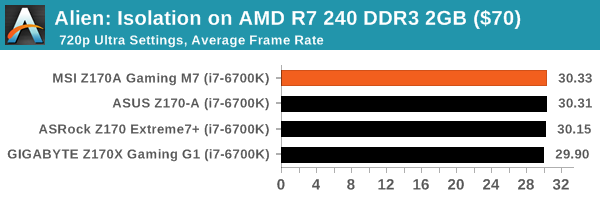
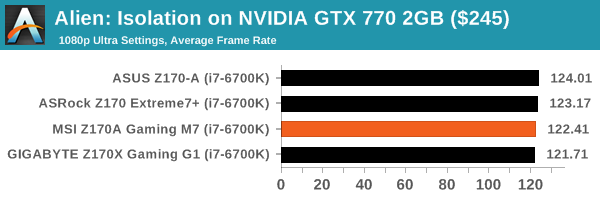
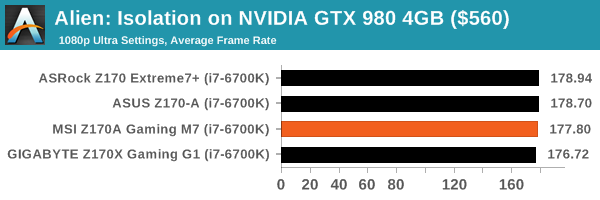
Total War: Attila
The Total War franchise moves on to Attila, another The Creative Assembly development, and is a stand-alone strategy title set in 395AD where the main story line lets the gamer take control of the leader of the Huns in order to conquer parts of the world. Graphically the game can render hundreds/thousands of units on screen at once, all with their individual actions and can put some of the big cards to task.
For low end graphics, we test at 720p with performance settings, recording the average frame rate. With mid and high range graphics, we test at 1080p with the quality setting. In both circumstances, unlimited video memory is enabled and the in-game scripted benchmark is used.
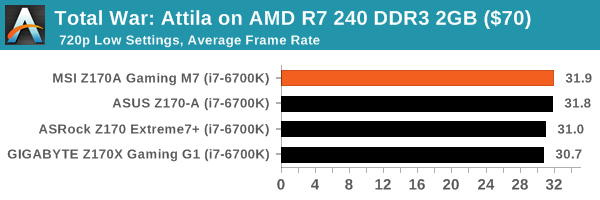
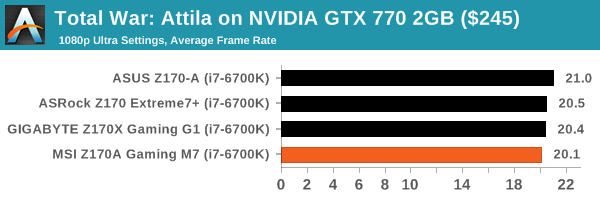
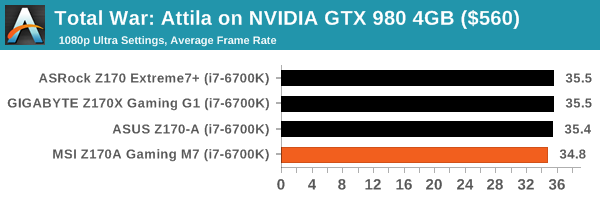
Grand Theft Auto V
The highly anticipated iteration of the Grand Theft Auto franchise finally hit the shelves on April 14th 2015, with both AMD and NVIDIA in tow to help optimize the title. GTA doesn’t provide graphical presets, but opens up the options to users and extends the boundaries by pushing even the hardest systems to the limit using Rockstar’s Advanced Game Engine. Whether the user is flying high in the mountains with long draw distances or dealing with assorted trash in the city, when cranked up to maximum it creates stunning visuals but hard work for both the CPU and the GPU.
For our test we have scripted a version of the in-game benchmark, relying only on the final part which combines a flight scene along with an in-city drive-by followed by a tanker explosion. For low end systems we test at 720p on the lowest settings, whereas mid and high end graphics play at 1080p with very high settings across the board.


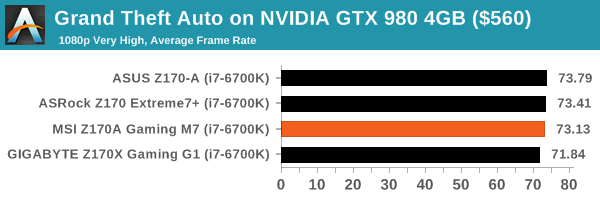
GRID: Autosport
No graphics tests are complete without some input from Codemasters and the EGO engine, which means for this round of testing we point towards GRID: Autosport, the next iteration in the GRID and racing genre. As with our previous racing testing, each update to the engine aims to add in effects, reflections, detail and realism, with Codemasters making ‘authenticity’ a main focal point for this version.
GRID’s benchmark mode is very flexible, and as a result we created a test race using a shortened version of the Red Bull Ring with twelve cars doing two laps. The car is focus starts last and is quite fast, but usually finishes second or third. For low end graphics we test at 1080p medium settings, whereas mid and high end graphics get the full 1080p maximum.

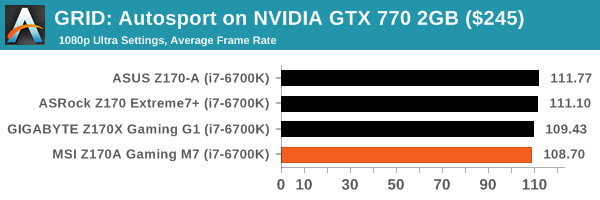

Middle-Earth: Shadow of Mordor
The final title in our testing is another battle of system performance with the open world action-adventure title, Shadow of Mordor. Produced by Monolith using the LithTech Jupiter EX engine and numerous detail add-ons, SoM goes for detail and complexity to a large extent, despite having to be cut down from the original plans. The main story itself was written by the same writer as Red Dead Redemption, and it received Zero Punctuation’s Game of The Year in 2014.
For testing purposes, SoM gives a dynamic screen resolution setting, allowing us to render at high resolutions that are then scaled down to the monitor. As a result, we get several tests using the in-game benchmark. For low end graphics we examine at 720p with low settings, whereas mid and high end graphics get 1080p Ultra. The top graphics test is also redone at 3840x2160, also with Ultra settings, and we also test two cards at 4K where possible.
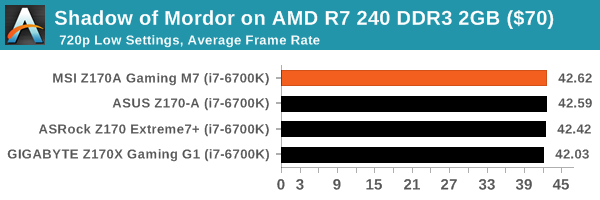
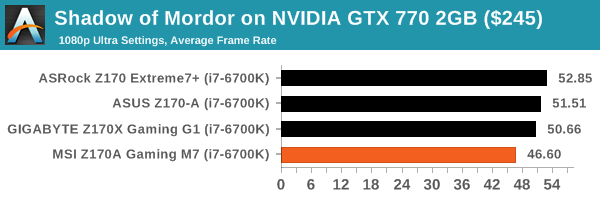
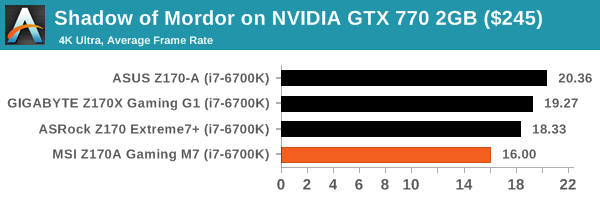
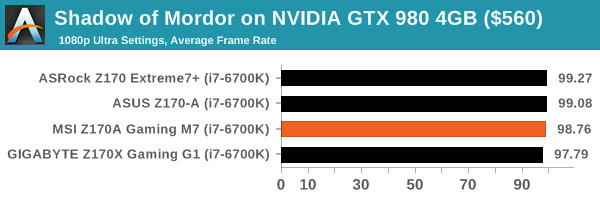
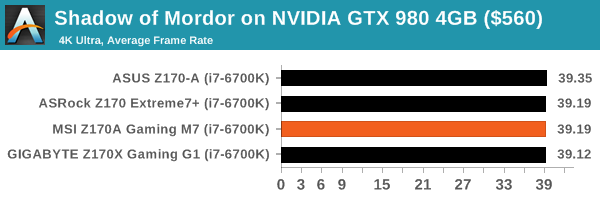
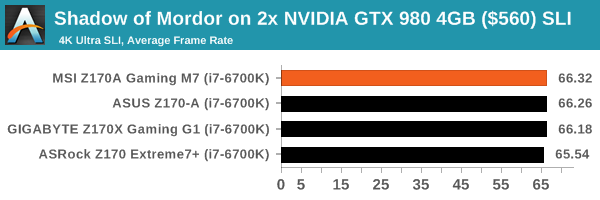















56 Comments
View All Comments
DanNeely - Tuesday, September 22, 2015 - link
I suspect the problem is that they ran out of high speed IO lanes for USB3 ports, didn't want to put 2.0 ports on (if they did someone else would be flaming them for doing so), and since this is a mid price board decided against using an onboard USB3 hub to add more ports. Having two x4 m.2 slots are probably to blame. The 1xx series chipset has a lot more IO than the 9x series that it replaced; but without using USB3 hubs or PLX chips it doesn't have enough to max out a full ATX board.prime2515103 - Monday, September 21, 2015 - link
This whole lack of HDMI 2.0 in PC's needed to end like a year ago.Ian Cutress - Monday, September 21, 2015 - link
HDMI is still not native to the Intel integrated graphics yet without a LS-PCon or Alpine Ridge (extra cost), but chances are with this motherboard that people will be using a discrete card. Pick a modern HDMI 2.0 capable one and you're set.Gigaplex - Monday, September 21, 2015 - link
Such as... the latest AMD Fury series? Still not supported. I think only Maxwell supports it so far. We need better support from the industry as a whole.artifex - Wednesday, September 23, 2015 - link
I thought the industry was moving to DisplayPort?DanNeely - Wednesday, September 23, 2015 - link
The PC industry is trying to move that way (in addition to a few minor technical advantages, to avoid paying HDMI royalties; a few cents/port adds up when you're making millions of something); consumer electronics and home theater are very HDMI oriented though, so we're probably stuck with it indefinitely too.ruthan - Monday, September 21, 2015 - link
eSata - is someone realy using this? External sata HDD connection woub be nice, but what about power for HDD, some USB to sata cable?Where is added value in comparision with usual Sata bracket connected to internal Sata port?
Few years ago seems, that this problem would solve eSataP - with included power but this standard died and we are still using USB3 to Sata bulky converters.
Gigaplex - Tuesday, September 22, 2015 - link
I use eSATA. My 3.5" enclosure is mains powered, and eSATA is much faster than USB 2.0.ppi - Monday, September 21, 2015 - link
Since I was considering this mobo, is it possible to:a) Disable Killer NIC prioritization; and
b) Disable Nahimic effects (no equallizer)?
Thanks.
K_Space - Monday, September 21, 2015 - link
I thought the number of lanes has not changed from what Haswell offers (?16 PCI-E 3.0)?Then excuse the noob question with regard to the 20 PCI lanes:
If you have CF running and an M.2 x4 PCI-E 3.0 SSD; can you be run 8x/8x for the CF and full x4 for the M.2 SSD?
The reason I ask is that I have an Extreme6 Z97 with a R9 295x2 on the first PCI-E 3.0 and an XP941 M.2 SSD in their UltraM.2 slot (also PCI-E 3.0). According to the AsRock manual (and CPU-Z confirms), the 295x2 is running @ x8, and the M.2 at x4. If I attempt to install another 295x2 (not that it is a good idea) I'm informed the second card would have to drop to x4 (8+4+4). Given that the 295x2 is dual GPU and linking through PCI-E, latency with x4 will probably not be ideal (I recall reading somewhere that up to x8 link speed won't hurt the 295x2 CF but anything lower might).
I may be confusing quite few concepts here so your patience and detailed explaination would be much appreciated!!